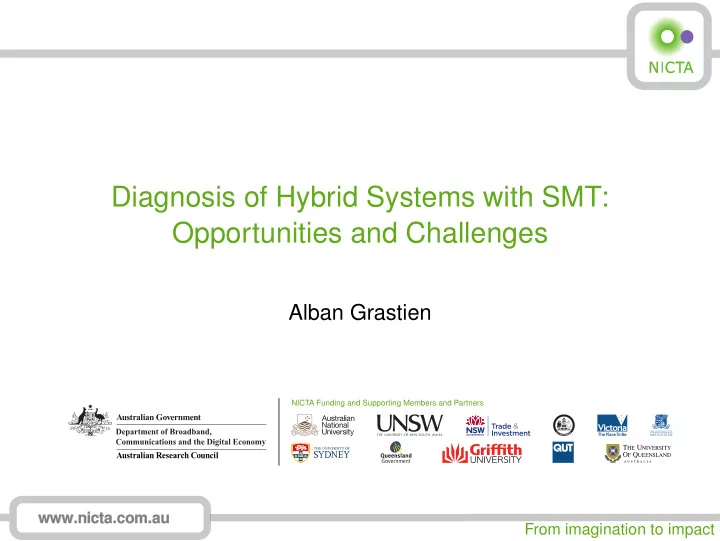

Diagnosis of Hybrid Systems with SMT: Opportunities and Challenges Alban Grastien NICTA Funding and Supporting Members and Partners www.nicta.com.au From imagination to impact
(Informal) Problem Definition Diagnosis Detect, identify, and isolate faults in a system given observations of the system’s behaviour. Model-Based Diagnosis A description of the system, i.e., a model, can be used to reason about the system’s behaviour. 2/17
Hybrid Systems Dynamic Systems the state variables of whom can vary discretely (finite number of changes) ∀ [ t , t ′ ] ∈ R 2 . ∃ k ∈ N . ∃ t = t 1 < · · · < t k = t ′ . ∀ τ, τ ′ ∈ ] t i , t i + 1 [ . v @ τ = v @ τ ′ ; vary continuously ∀ [ t , t ′ ] ∈ R 2 . ∀ ν ∈ ] v @ t , v @ t ′ [ ⇒ ∃ t ν ∈ [ t , t ′ ] . v @ t ν = ν ; exhibit both types of behaviour. 3/17
Existing Approaches Separate the continuous aspects from the discrete ones: 1 loses interconnection between the variables Indicators on the continuous variables estimate the current discrete state Discrete event systems techniques verify that the evolution of the discrete state is consistent with the model Hybrid state tracking (particle filters, etc.): requires 2 predictive (probabilistic) models As opposed to diagnosis of DES, different approaches imply different models and different capabilities 4/17
Our Approach Diagnosis ` a la de Kleer, Reiter, Williams Diagnostic Test Verify the consistency between the model, the observations, and some assumption (reduced to BMC / SMT) Diagnostic Algorithm Generate the diagnostic tests in order to produce the diagnosis ( → DX-11) 5/17
Satisfiability Modulo Theory SAT with an underlying theory Examples of theories: bit-vectors and arrays, linear and non-linear arithmetics, recursive datatypes, default logic, etc. We are interested in linear arithmetics: ( A ∨ B ) ∧ ( x − y ≥ 0 ) ∧ ( ¬ A → ( y < 9 )) ∧ . . . 6/17
Bounded Model Checking for Hybrid Systems Model-Checking Verify reachability properties over hybrid systems (example: mutexes) Bounded MC Search for (counter-)examples that involve n (discrete and continuous) transitions Reduction from Diagnosis Test to BMC A diagnostic test is satisfiable iff there exists a path on the model that generates the observations and satisfies the assumption 7/17
Translating a Diagnostic Test into SMT Defining the SMT Variables For all state variable v and all timestep t , is defined a variable v @ t For all timestep t , is defined a variable time @ t ⇒ a timestep is an instant! For all event e and all odd timestep t , is defined a variable e @ t 8/17
Translating a Diagnostic Test into SMT Discrete Variables For every timestep t , e @ t → prec ( e )@ t CB trip @ t → ( current @ t > 80 ) For every timestep t , e @ t → effect ( e )@( t + 1 ) CB trip @ t → open @( t + 1 ) For every discrete state variable v , v @ t � = v @( t + 1 ) → � e ∈ affecting ( v ) e @ t ( ¬ open @ t ∧ open @( t + 1 )) → ( CB trip @ t ∨ CB operated @ t ) 9/17
Translating a Diagnostic Test into SMT Continuous Variables For every timestep t , for every continuous variable v , time @ t = time @( t + 1 ) → v @ t = v @( t + 1 ) time @ t = time @( t + 1 ) → tpt @ t = tpt @( t + 1 ) For every timestep t , for every continuous variable v , continuous constraint ( v , t , t + 1 ) tpt increasing @ t → (( tpt @( t + 1 ) − tpt @ t ) ≥ 10 × ( time @( t + 1 ) − time @ t )) 10/17
Translating a Diagnostic Test into SMT State-based observations: obs variable @ obs time = obs value (but the noise must be implemented into the model) Assumption: similar to diagnosis by SAT ¬ f 1 occed @ n ∧ f 2 occed @ n ∧ ¬ f 3 occed @ n 11/17
Experiments Adapt-Lite System 10 components 16 sensors 129 real-valued state variables 154 Boolean state variables 5-second windows (10 obs.) Preferred-First Strategy [DX11] SMT solver Z3 version 4.3.1 (similar results with cvc3 ) 12/17
Results Prob. instance Time (s) Card # δ 1 3.428 0 1 2 5.314 1 2 3 5.298 1 1 4 3.476 1 1 5 6.477 2 4 13/17
Results Prob. instance Time (s) Card # δ 1 3.428 0 1 2 5.314 1 2 3 5.298 1 1 4 3.476 1 1 5 6.477 2 4 Most of the runtime is on solving satisfiable problems Existing methods run faster but assume that fault patterns can be derived from the model Enormous scope for improvement: Already significant improvement from DX-13 Simply removing redundant variables simplifies the SMT problems 13/17
Benefits of the Approach Does not require a predictive model Is very flexible wrt. observations Justifies both diagnoses and non diagnoses 14/17
Second Round of Experiments Existing methods rely on strong assumptions about observability What happens when observability is variable? Remove observations at random 15/17
Issues to Solve Improve performance: similar to Bounded-Model Checking or SAT planning Incremental computation (cf. work with Frank Su) 16/17
Conclusion SMT techniques can be used to solve diagnosis problem of hybrid systems First solution that integrates all the dimensions of the problem Very flexible wrt model and observations Many problems remain to be addressed, but they are well-identified 17/17
Recommend
More recommend